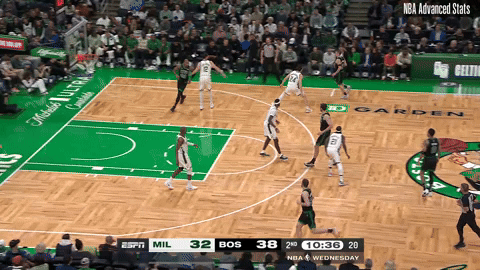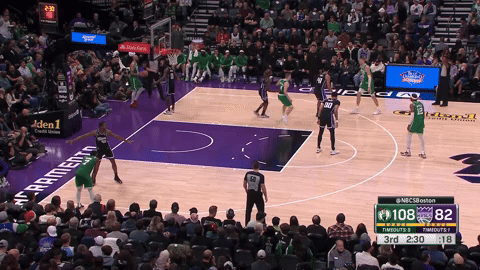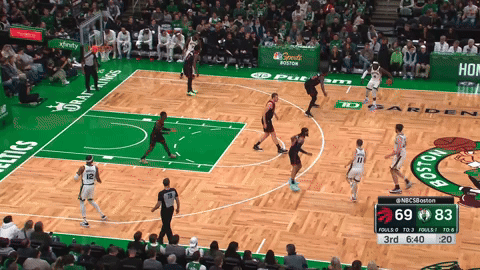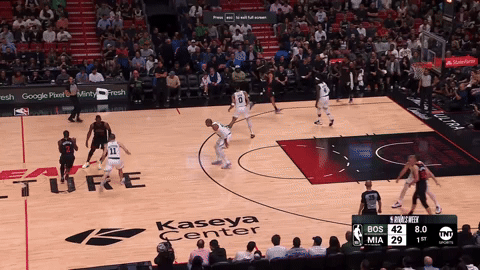Pritchard powers up: Thoughts on his offensive surge over the past few months
Payton Pritchard has been CRUSHING it lately...Can he keep it going in the playoffs?
The regular season is over, and the playoffs are looming. Right now, the Boston Celtics are awaiting the results of the play-in tournament so they can learn who their opponent will be in the first round of the playoffs. Later this week, we will dive deeper into potential opponents before ending the week with a scouting report.
For today, though, I wanted to dive into Payton Pritchard’s recent breakout on offense. The fourth-year guard strung together a solid run of games to close out the season. Even if we exclude the final outings against the Charlotte Hornets and Washington Wizards, there’s still a lot to like from the 6-foot-1 ball-handling wizard.
We all knew Pritchard could be a sparkplug off the bench. We’ve seen the scoring outbursts before. This is the same player who had his head coach apologizing after he went off in a game versus the Portland Trail Blazers during Ime Udoka’s lone season with the team.
You remember that game, right? Pritchard had 19 points off the bench, going 5-of-10 from deep in a 145-117 dissection.
“I mean, (we’re) hitting shots so I don’t know what they want us to do,” Pritchard said after that game. “I mean, at the same time, I get it if you’re like free-balling it but we just (were) playing ball, hitting shots.”
A lot has changed since then. The roster looks wildly different, the coaching staff has changed, and Pritchard is proving himself as one of the best bench guards in the league.
Under Brad Stevens, when Pritchard was in his rookie year, he was used almost exclusively as a two-guard. It was a similar road with Udoka, as the rookie head coach urged the Orgeon product to become a better screener and off-ball threat.
“He’s obviously one of our best shooters,” Udoka said in March, 2022. “The trick for him was to learn to play off the ball more and understand that we have Marcus, Derek, Jayson, Jaylen that can all handle and create shots for him. At times, he’s a great screener and popper and he mixes it up and we bring some smaller matchups into it. So he’s done a great job of not just handling it but playing off the ball.”
Pritchard was drafted with the 26th pick in 2020. Here are his average touches per game over his first four years in the league.
As we can see, the ball isn’t in his hands more than in previous years, not in terms of how many touches he gets per minute of the floor. Interestingly, he’s touching the ball at the same rate he did last season, where he was stuck behind Malcolm Brogdon for the entire season.
He’s also not scoring at a higher rate in terms of points per touch.
He is, however, scoring more efficiently on slightly increased volume.
The key takeaway is that Pritchard’s per-minute production metrics have held steady, indicating he is maximizing his opportunities rather than simply getting more of them.
And that’s where two of his offensive improvements come into play. Let’s look at some of the game film.
Creation via contact
When Pritchard entered the NBA, he did so as a sharpshooting specialist who was slightly undersized for his position. There were questions surrounding his ability to develop into a two-level scorer and whether he could create for himself and others off the dribble at the NBA level.
This season, Pritchard has answered those questions. His most recent development has seen him become a reliable scoring option around the rim. Rather than sprinting into the paint and getting tapped by the defense, Pritchard varies his dribble, changes speed and direction, and creates contact around the rim to generate separation from his defender.
This clip is from Boston’s game against the New York Knicks on Thursday. Watch how he slows down, uses his crossover to fake going right before driving into the paint, and then creates contact via a bump-off to open enough space for him to get his shot off.
That “bump creation” has become a stalwart in how Pritchard generates quality looks around the rim, and is a primary reason why he’s now safely viewed as a two-level scorer.
Here is another example. This time against Pat Connaughton of the Milwaukee Bucks. Once again, Pritchard switches up his dribble, toys with his defender by consistently changing his pace of play and then explodes on a baseline cut before creating separation on the bump.
It’s no surprise that Pritchard’s accuracy within four feet of the basket has taken a significant leap this season. Per Cleaning The Glass, Pritchard is converting on 74% of his attempts around the rim this season, up from 53% last season, 55% the year before and 60% when he was a rookie. Interestingly, he’s had two seasons where he has taken more attempts around the rim; those occurred in 2022-23 and 2020-21.
The Nash dribble
The above clip has three examples of Pritchard’s Nash Dribble. Credit Wayne Spooney for sharing this on Twitter — it saved me the job of going through and finding some clips.
A Nash dribble is when you drive toward the rim and then keep the dribble alive as you go under it and into the second side — It was made popular by Steve Nash, hence the name.
Pritchard’s speed and passing ability has ensured that he creates high quality opportunities when Nashing his dribble — either for himself as he bumps off his defender, or for others. There are times when he will hit a quick shovel pass to a cutter or a big that has relocated into the paint as Pritchard Nash’s, and others when he will swing the ball back out to the perimeter as the defense rotates to the threat of him being around the rim.
With his low center of gravity, elite ball-handling, and ability to change pace and direction at will, Pritchard is a tough cover when he’s operating under the rim. He’s proven to be a threat he he seals his defender onto his hips, or when he’s got them behind him and is putting them ‘in jail.’
***The Celtics Chronicle is running a special offer on paid subscriptions before the postseason begins.***
For the next week, I’m offering paid subscriptions to the newsletter at a 40% discount for your first year — both monthly and yearly plans. That will cover you throughout the playoffs, the offseason and all of the 2024-25 regular season.
For just $3 per month or $36 for the year, you will get:
Scouting reports
X’s and O’s breakdowns
Cross-over discussions with other writers from around the league
Analysis posts
Thoughts on news, rumors, and trending topics
And the occasional editorial.
I’m always looking to add more to the offering, too, and I am working towards higher consistency and volume ahead of next season.
Some other observations
Outside of his ability to create separation via contact and increasing usage of the Nash dribble, Pritchard has also been an effective offensive rebounder this season. For some reason, he continually finds himself in the perfect position to sneak in and garner second-chance opportunities for his team.
Cleaning The Glass has Pritchard in the 86th percentile among guards when it comes to grabbing offensive boards this season.
Pritchard’s initial years under Stevens and Udoka have ensured he’s developed a screening game. He’s a valuable inverted screener, allowing the Celtics to hunt mismatches with him on the perimeter, especially when looking to have him pop off the screen and provide spacing on the wings or in the slot.
That screening doesn’t always mean that Pritchard is operating as a screener in pick-and-roll actions. Here, he is running some “wedge veer” in an off-ball role. His first wedge screen is to get Kristaps Porzingis into the post. His second screen is for Oshae Brissett and is a flare screen at the nail. These screens create significant space above the three-point line, allowing Pritchard to pop out while giving him ample time to attack the defensive closeout when the ball finds him and step into his spot before firing off the three.
Here is Pritchard operating as an inverted screener again, this time for Jrue Holiday as part of a stagger screen. Pritchard ghosts his screen and pops onto the wing, allowing Holiday to penetrate and spray the ball back out for a catch-and-shoot three. For reference, Pritchard is shooting 42.6% on 5.1 3-Point C&S opportunities per game this season.
For all the talk of Pritchard being a liability on the defensive end, he’s held his own rather well this season. I’m a firm believer that defense is a team-centered activity. I don’t think catch-all metrics do a great job of illustrating how one mistake from a member of the defensive rotation can negatively impact the other four defenders on the floor. However, I do think there’s value in some of the catch-alls, at least in terms of giving a league-relative picture of how a player is performing. Personally, I like D-EPM and DFG%.
Defensive Estimated Plus-Minus (D-EPM) is a player impact metric that measures a player's defensive contribution by using a statistical plus-minus model with a box score prior, accounting for all players in the league, and regularizing the values to provide a comprehensive, league-relative estimate of a player's defensive impact in points per 100 possessions. Typically, D-EPM values range from around -7.0 ( VERY poor defense) to +7.0 (INSANELY elite defense), with the average player having a D-EPM of 0.0.
DFG% is how well-opposing players have shot when being guarded by the player in question.
Pritchard has a -1.3 D-EPM this season. He also has a DFG percentage of 48.9%, guarding 6.5 shot attempts per game.
The above clip is one that stood out to me earlier this season. Pritched is at his best on defense when he’s blowing up passing lanes or getting into a ball-handler’s pocket. What we can see above is the Miami Heat running a “zoom” action, also known as “Chicago” with Pritchard peel switching onto the ball-handler, pressuring the dribble and forcing the turnover.
Final thoughts
Pritchard has undoubtedly improved this season. He has certainly had a slightly bigger role; however, that hasn’t translated into more opportunities. Instead, his improvements have been the reason for his efficient play and improved impact on the offensive side of the floor.
Joe Mazzulla may need to get a little creative on the defensive end during the post-season just to ensure that Pritchard remains a positive factor on both sides of the floor. Nevertheless, he’s not been an awful defender by any stretch…although he is likely one of the weaker points in Boston’s system.
Nevertheless, Pritchard has proven himself to be a reliable first guard off the bench who can run an offense, provide scoring, spacing and some hustle plays, and will fight tooth and nail on the defensive end. He could end up having a big impact during the playoffs — especially if his recent production continues.
If you’re new here and want to test out a free subscription, you can do so here










